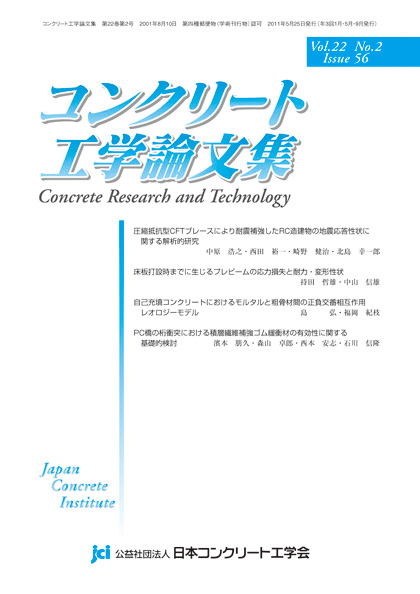All issues

Volume 19 (2008)
- Issue 3 Pages 1-
- Issue 2 Pages 1-
- Issue 1 Pages 1-
Volume 19, Issue 2
Displaying 1-4 of 4 articles from this issue
- |<
- <
- 1
- >
- >|
-
Hidenori Tanaka, Takahiro Sakai, Osamu Taniguchi, Hideharu Naitou2008Volume 19Issue 2 Pages 1-10
Published: May 25, 2008
Released on J-STAGE: November 13, 2012
JOURNAL FREE ACCESSIn this study, by using parametric studies of the straight length of right angle hook, we researched the effects on anchoring and shearing strength of reinforced concrete (RC) members which have the hook of shear reinforcements. The static tensile and high stress cyclic tests about anchoring and then the static tests as RC about shearing were carried out. According to the both results, even though the length of hook was reduced by 37.5% (L=90mm) of the standard length (L=240mm), it was found that the anchoring and shearing strength were almost same as the result of standard case.View full abstractDownload PDF (1758K) -
Taku Matsuda, Hiroshi Kawakami, Yoshikatsu Nishimoto2008Volume 19Issue 2 Pages 11-19
Published: May 25, 2008
Released on J-STAGE: November 13, 2012
JOURNAL FREE ACCESSCreep tests were conducted on ultra-high-strength concrete with a design strength level of 150 N/mm2, with the parameters being the loading stress, loading age, stepwise increase in the loading stress, and application of high temperatures at early ages. As a result, the creep strain decreased as the loading stress decreased, as the loading age increased, and with high temperature curing at early ages. Also, when using a conventional prediction model, it was found necessary to correct the model by adequately incorporating the effects of the loading stress, loading age, and early-age high temperature curing, so that the creep behavior of an actual structure can be more accurately predicted.View full abstractDownload PDF (1765K) -
Yoshimichi Aono, Matsushita Fumiaki, Shibata Sumio, Yukio Hama2008Volume 19Issue 2 Pages 21-34
Published: May 25, 2008
Released on J-STAGE: November 13, 2012
JOURNAL FREE ACCESSPore structural changes in hardened cement pastes, subjected to drying and wetting/drying cycles, were studied at micrometer and nanometer levels. Characterization techniques included NMR, nitrogen and water vapor adsorption, mercury intrusion porosimetry and under water weighing. Coarsening of pore structure and increase in the true density were observed. Decrease in specific surface area due to drying was observed with water vapor adsorption associated with Excess Surface Work (ESW) analysis suggested a development of cohesive and layered structure in C-S-H. The results of NMR confirmed polymerization of silicate anion chains. A model of change in nanostructure of C-S-H during drying was proposed. The deterioration of frost resistance is better examined by the coarsening of pore size distribution rather than cracking.View full abstractDownload PDF (2373K) -
Yoshihiro Yoneyama, Shin-ichi Igarashi2008Volume 19Issue 2 Pages 35-45
Published: May 25, 2008
Released on J-STAGE: November 13, 2012
JOURNAL FREE ACCESSMicrostructure in cement pastes revealed by BSE image analysis was quantitatively compared with a structure simulated by CEMHYD3D. At a water/cement ratio of 0.25, the spatial structures of unhydrated cement particles and coarse capillary pores were sufficiently simulated by the model. At water/cement ratios of 0.40 and 0.60, judging from visual impression, the simulated structures are similar to real ones. However, its geometric features in terms of spatial statistics, especially capillary pores do not agree with the real structure. This discrepancy results from the differences in porosity and pore size to be compared in the two methods. It should be noted that quantitative comparison between real and simulated structures is meaningful only when there are little pore finer than the resolution in each image.View full abstractDownload PDF (3033K)
- |<
- <
- 1
- >
- >|